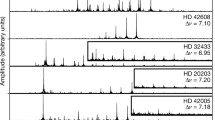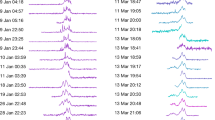Abstract
FIVE new pulsars have been discovered in a systematic search at low galactic latitudes, using the Mark I radio telescope at Jodrell Bank, and a radio frequency of 408 MHz. A total of 431 independent points were observed (many of them more than once) at integral degrees of galactic latitude and longitude, including all such points with latitude −1, 0, and + 1° and longitude 11° ≤l≤ 125°. The beamwidth of the telescope to half power was 0°.8.
This is a preview of subscription content, access via your institution
Access options
Subscribe to this journal
Receive 51 print issues and online access
$199.00 per year
only $3.90 per issue
Buy this article
- Purchase on Springer Link
- Instant access to full article PDF
Prices may be subject to local taxes which are calculated during checkout
Similar content being viewed by others
References
Craft, H. D., and Comella, J. M., Nature, 220, 676 (1968).
Smith, F. G., Nature, 223, 934 (1969).
Rankin, J., Symposium on Pulsars and High Energy Activity in Supernova Remnants, Rome, December (1969).
Author information
Authors and Affiliations
Rights and permissions
About this article
Cite this article
DAVIES, J., LARGE, M. & PICKWICK, A. Five New Pulsars. Nature 227, 1123–1124 (1970). https://doi.org/10.1038/2271123a0
Received:
Issue Date:
DOI: https://doi.org/10.1038/2271123a0
This article is cited by
-
The Lovell Telescope and its role in pulsar astronomy
Nature Astronomy (2017)
-
Timing results for thirteen pulsars
Nature (1974)
-
New and Improved Parameters for Twenty-two Pulsars
Nature Physical Science (1972)
-
Pulsar Associated with the Supernova Remnant IC 443
Nature (1972)
-
Profiles of the diffuse interstellar lines
Astrophysics and Space Science (1972)
Comments
By submitting a comment you agree to abide by our Terms and Community Guidelines. If you find something abusive or that does not comply with our terms or guidelines please flag it as inappropriate.



